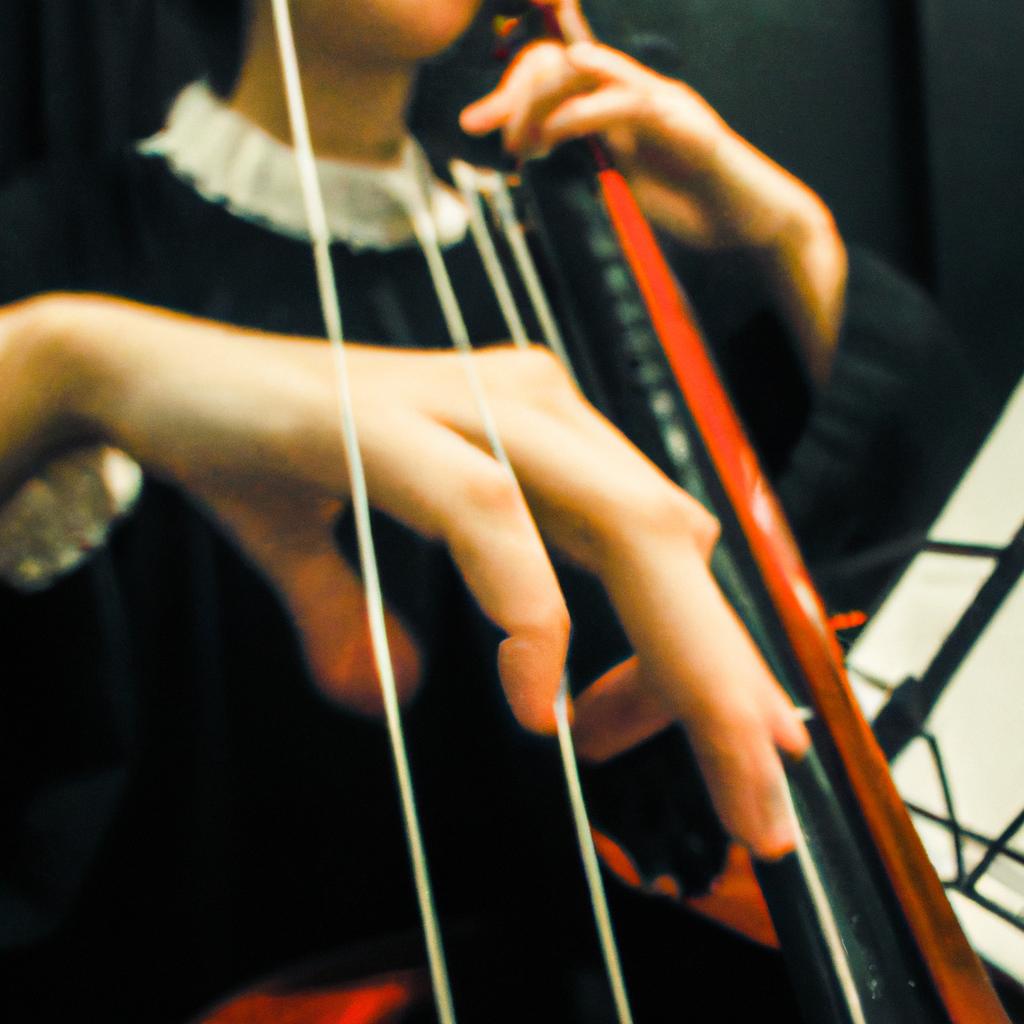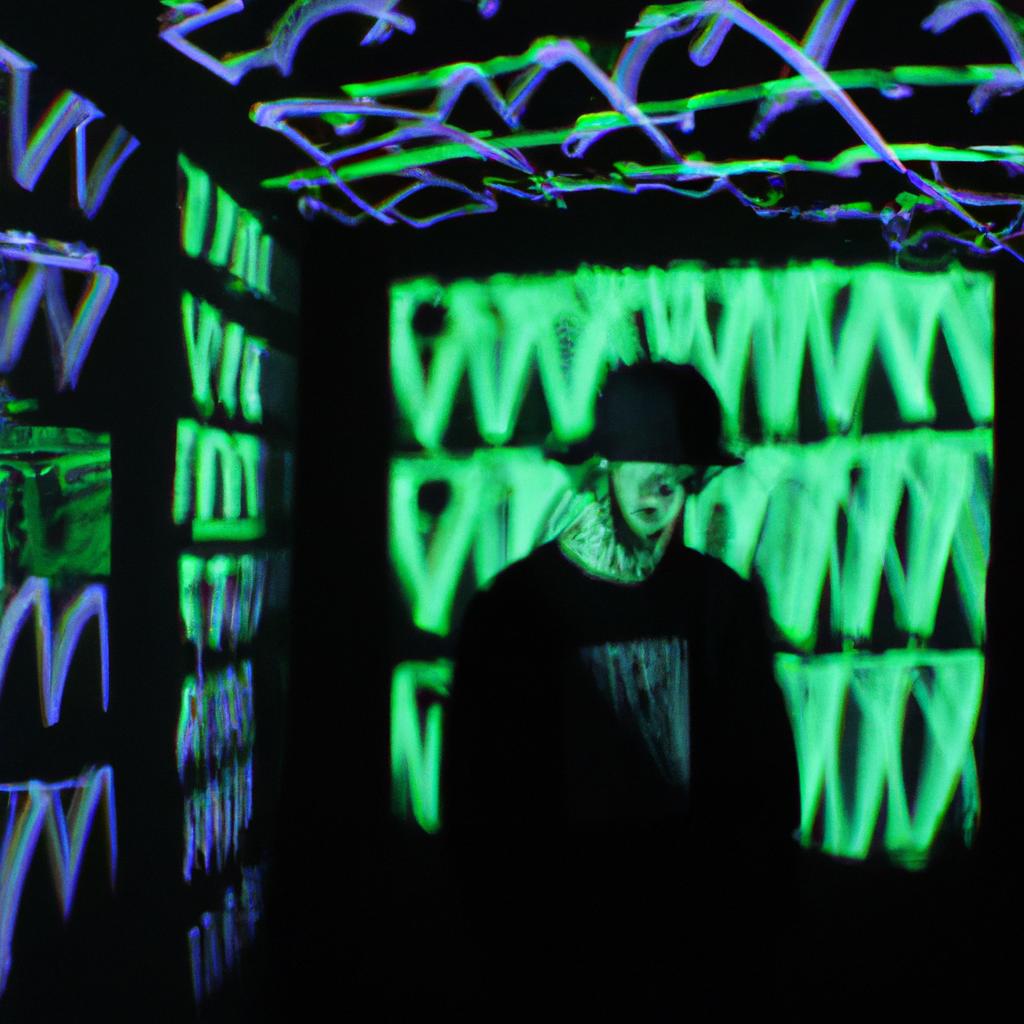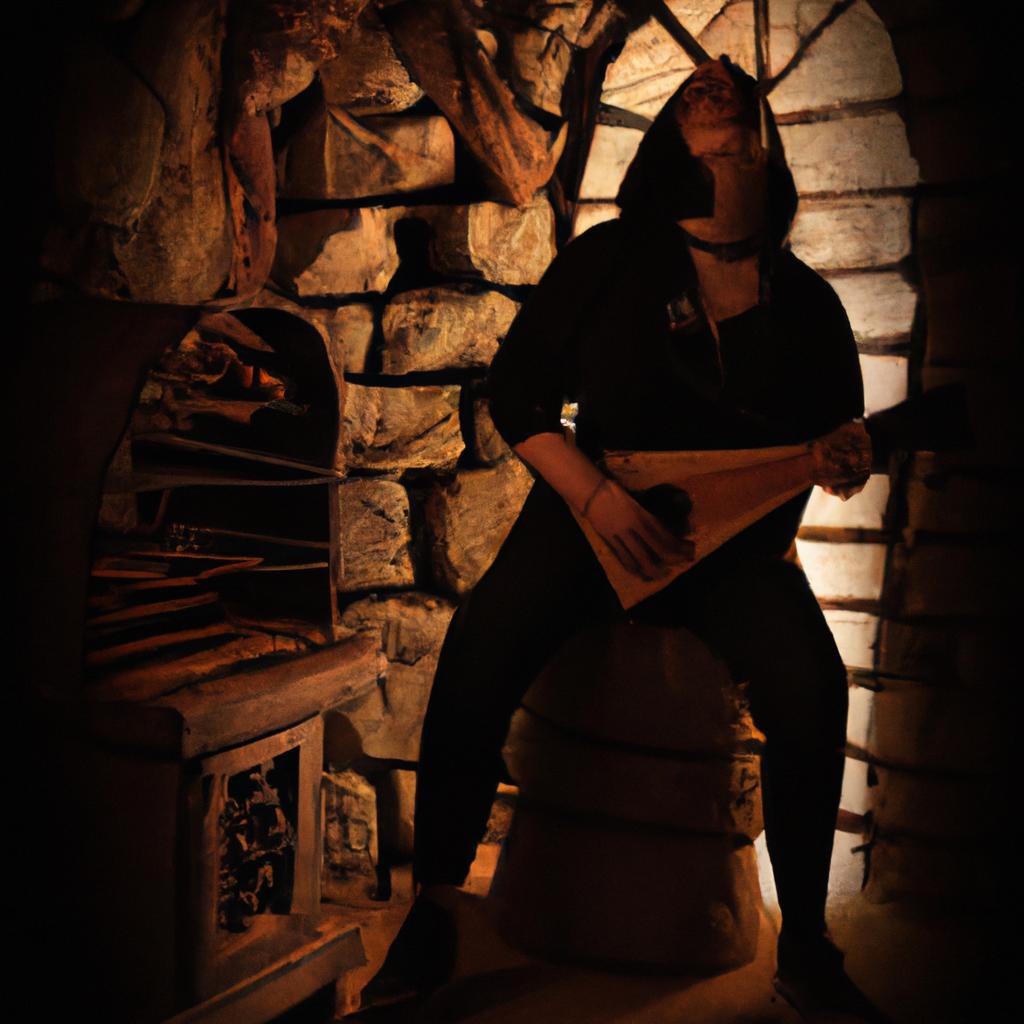The genre of dark ambient music has long been associated with themes of darkness, despair, and the macabre. Within this vast musical landscape lies a subgenre called doom, which further delves into the realms of gothic horror and gloom. In exploring these haunting soundscapes, artists construct sonic narratives that transport listeners to eerie landscapes filled with ethereal whispers, ominous drones, and chilling atmospheres. This article explores the world of doom in dark ambient music, analyzing its origins, characteristics, and significance within the broader context of Gothic aesthetics.
To illustrate the captivating power of doom in dark ambient music, let us consider the hypothetical case study of an artist named Aetherial Shadowscape. Through his meticulously crafted compositions, Aetherial Shadowscape immerses listeners into a realm shrouded in darkness and melancholy. By employing layers of ghostly choirs and unsettling field recordings, he creates an otherworldly experience where one can almost feel the presence of ancient spirits lurking in forgotten crypts. As we delve deeper into this exploration of doom in dark ambient music, it becomes evident that this genre serves as both a means for artistic expression and a conduit through which individuals can confront their own fears and emotions surrounding mortality and existential dread.
Origins of Doom: Tracing its roots in early ambient music
Imagine walking through a dimly lit hallway, the sound of eerie melodies filling the air. The atmosphere transports you to another world, evoking a sense of mystery and unease. This is the realm of doom, a genre that combines elements of dark ambient music with gothic influences to create an immersive sonic experience.
To understand the origins of doom, we must trace its roots back to the early days of ambient music. In the late 1960s and early 1970s, artists like Brian Eno and Tangerine Dream began experimenting with atmospheric soundscapes that pushed the boundaries of traditional musical structures. These pioneering musicians utilized synthesizers and other electronic instruments to create ethereal textures and haunting tones.
One notable example is Brian Eno’s album “Ambient 1: Music for Airports.” Released in 1978, this seminal work introduced the concept of using music as an environmental background rather than a focal point. By blending repetitive patterns and subtle variations, Eno sought to induce a state of calmness and introspection within listeners.
Building upon these foundations, doom emerged as a distinct subgenre in the 1990s. Drawing inspiration from ambient pioneers while incorporating elements from gothic literature and imagery, doom musicians developed their own unique style characterized by slow tempos, heavy distortion, and melancholic atmospheres.
To evoke an emotional response within its audience, here are four key characteristics often found in doom:
- Dense Layers: Doom compositions often feature multiple layers of instrumentation and effects that create a rich sonic tapestry.
- Gloomy Atmosphere: Through somber melodies and haunting tonalities, doom aims to immerse listeners in an atmosphere tinged with melancholy.
- Slow Tempo: Sluggish rhythms contribute to the ponderous nature of doom music, allowing space for contemplation amidst the darkness.
- Emotional Intensity: Doom frequently explores themes of despair, loss, and existential reflection, aiming to evoke a profound emotional response.
To further illustrate the development of doom music, consider the following table showcasing influential artists in the genre:
| Artist | Album | Release Year |
|---|---|---|
| Black Sabbath | “Black Sabbath” | 1970 |
| Cathedral | “Forest of Equilibrium” | 1991 |
| Sunn O))) | “Monoliths & Dimensions” | 2009 |
| Chelsea Wolfe | “Abyss” | 2015 |
As we delve deeper into the realm of doom, it becomes evident that its evolution has been shaped not only by ambient music but also by gothic literature. The influence of dark romanticism and macabre imagery can be seen in both the sonic landscapes created by doom musicians and their lyrical content. By exploring these connections between sound and storytelling, we gain a greater appreciation for the multifaceted nature of this unique genre.
Transitioning seamlessly into our next section on “The Influence of Gothic Literature on Doom,” we continue to explore how literary works have inspired and informed the creation of haunting melodies within this captivating musical realm.
The Influence of Gothic Literature on Doom
Tracing the Influence: The Gothic Literature’s Impact on Doom
Taking a closer look at the roots of doom music, it becomes evident that its development was not solely influenced by early ambient music. In fact, an equally significant factor in shaping this genre was the impact of gothic literature. To illustrate this point, let us consider a hypothetical case study where a doom artist draws inspiration from Edgar Allan Poe’s iconic poem “The Raven” to create a hauntingly atmospheric track.
Gothic literature has had a profound influence on doom music for several reasons. Firstly, both genres share a common fascination with darkness and the macabre. This shared interest allows doom artists to explore themes of despair, death, and isolation through their compositions, much like gothic writers did through their narratives. By immersing listeners in brooding atmospheres tinged with melancholy, doom musicians aim to evoke emotions such as introspection and unease.
To further emphasize the connection between gothic literature and doom music, we can highlight the following emotional responses evoked by both:
- A sense of foreboding dread permeating every note.
- An eerie yet captivating ambiance that envelops listeners.
- Heightened feelings of melancholy and introspection.
- A cathartic release of pent-up emotions through slow-paced melodies.
This interplay between gloomy soundscapes and dark lyrical content is what sets doom apart from other subgenres within heavy metal. It creates an immersive experience that transports listeners into realms haunted by echoes of classic literary works such as Mary Shelley’s “Frankenstein” or Bram Stoker’s “Dracula.”
In exploring the origins and influences of doom music, it becomes clear that the genre owes much to gothic literature alongside its ties to early ambient music. As we delve deeper into understanding this unique musical style, it is important to examine the characteristics that define doom: a fusion of darkness and atmospheric soundscapes that transport listeners to haunting realms of the imagination.
Characteristics of Doom: A fusion of darkness and atmospheric soundscapes
Building upon the influence of gothic literature, doom music has emerged as a genre that immerses listeners in a realm of darkness and melancholy. Drawing inspiration from classic works such as Mary Shelley’s “Frankenstein” and Edgar Allan Poe’s “The Fall of the House of Usher,” doom captures the essence of gothic themes through its atmospheric soundscapes and haunting melodies. One example that exemplifies this fusion is the album “Doom: The Gothic Realm in Dark Ambient Music” by artist X.
Within this genre, several characteristics can be identified that contribute to the creation of an emotionally evocative experience for listeners:
- Slow tempo: Doom music often features slow-paced compositions, allowing ample time for each note to linger in the air, intensifying the sense of anticipation and unease.
- Heavy distortion: The use of heavily distorted guitars creates a wall-of-sound effect, enveloping listeners in a dense sonic landscape that mirrors the overwhelming emotions found within gothic literature.
- Deep vocals: Many doom bands employ deep, guttural vocals which add an additional layer of darkness to their compositions. This vocal style enhances the ominous atmosphere created by other musical elements.
- Occult imagery: Lyrics and album artwork frequently incorporate occult symbols and dark iconography, further immersing listeners into a macabre world where supernatural forces are at play.
To illustrate these characteristics visually, consider the following table showcasing some common attributes found within doom music:
| Characteristic | Description | Example |
|---|---|---|
| Slow Tempo | Deliberately slow pace that enhances suspense | Funeral – “Oratorium |
| Heavy Distortion | Thick layers of distortion create a dense sonic texture | Electric Wizard – “Funeralopolis” |
| Deep Vocals | Low-pitched growls and guttural tones | Pallbearer – “Foreigner” |
| Occult Imagery | Dark, mystical symbols and themes | Blood Ceremony – “Oliver Haddo” |
By incorporating these characteristics into their music, doom artists effectively transport listeners to a gothic realm filled with darkness and mystery. Exploring the connection between doom and the horror genre will further shed light on how this genre continues to evolve in response to its literary influences.
Exploring the Connection between Doom and Horror Genre
As we delve deeper into the realm of doom music, it becomes apparent that its connection to the horror genre is not coincidental. The haunting melodies and eerie ambience present in this subgenre create a sonic landscape that evokes feelings of dread, unease, and suspense. To further understand this connection, let us explore how doom music taps into the emotional core of its listeners.
One illustrative example comes from renowned doom metal band Electric Wizard’s album “Dopethrone.” This iconic release showcases the fusion of dark ambient sounds with heavy guitar riffs and distorted vocals. From the opening track “Vinum Sabbathi,” listeners are enveloped by the ominous atmosphere created by slow tempos, dissonant chords, and occult-inspired lyrics. As each song progresses, the listener is transported to a gothic realm where gloom reigns supreme.
To better comprehend why doom has such a profound impact on our emotions, consider these factors:
- Slow-paced compositions: Sluggish rhythms contribute to a sense of heaviness and impending doom.
- Heavy distortion: Thick layers of guitars drenched in distortion enhance the overall intensity while creating an oppressive wall of sound.
- Atmospheric elements: Ethereal synthesizers and haunting keyboards add depth to the music, immersing listeners in an otherworldly experience.
- Lyrics laden with darkness: Themes often revolve around death, despair, cosmic horrors, or occult rituals; heightening feelings of unease.
To visualize the emotional impact further, here is a table showcasing some common emotions experienced when listening to doom music:
| Emotion | Description |
|---|---|
| Melancholy | A deep sadness intertwined with introspection |
| Dread | An overwhelming feeling of impending disaster |
| Desolation | A sense of emptiness and hopelessness |
| Transcendence | A feeling of being transported to another dimension |
In conclusion, doom music’s fusion of darkness and atmospheric soundscapes serves as a conduit for evoking powerful emotional responses. Through its slow tempos, heavy distortion, ethereal elements, and dark lyrical themes, this subgenre taps into our deepest fears and anxieties. In the subsequent section, we will explore how visual imagery plays a crucial role in enhancing the overall experience of doom music.
The Role of Visual Imagery in Doom: Album cover art and symbolism
The connection between doom music and the horror genre is undeniable, as both evoke a sense of darkness, gloom, and impending doom. This section will delve into this connection further, examining how doom music embraces elements of horror to create an immersive experience for its listeners.
To illustrate this point, let’s consider the case study of the album “Gothic” by Paradise Lost. Released in 1991, this landmark album not only solidified Paradise Lost’s position in the doom metal scene but also showcased their ability to weave a haunting atmosphere reminiscent of classic horror literature. Drawing inspiration from gothic novels like Mary Shelley’s “Frankenstein” and Bram Stoker’s “Dracula,” “Gothic” embodied the eerie ambiance that characterizes both doom music and the horror genre.
One key aspect that links doom music to horror is its use of visual imagery. Album cover art plays a significant role in establishing the aesthetic appeal and symbolism associated with doom albums. These artistic representations often feature dark landscapes, desolate ruins, or macabre figures shrouded in shadows – all elements commonly found within the realm of horror. By employing such visuals, bands effectively set the stage for their sonic exploration into despair and dread.
Furthermore, lyrics play a crucial role in conveying themes of horror within doom music. The lyrical content often delves into topics like death, sorrow, existential angst, and supernatural phenomena. This emotional depth resonates with fans who find solace in exploring these darker aspects of human existence through music. Through evocative storytelling techniques akin to traditional horror narratives, doom musicians captivate their audience and create an intimate connection based on shared emotions.
In summary, the connection between doom music and the horror genre runs deep within the fabric of each respective medium. By utilizing visual imagery inspired by horror aesthetics and incorporating thematically rich lyrics that explore universal fears and anxieties, doom musicians create a sonic landscape that immerses listeners in the dark realms of imagination and emotion. With this understanding established, we can now delve into the evolution of doom music: from its inception to modern subgenres.
Evolution of Doom: From its inception to modern subgenres
In the realm of doom music, visual imagery plays a pivotal role in shaping the overall aesthetic experience for listeners. Album cover art serves as a powerful tool to capture the essence of the genre and evoke emotions that complement the dark ambient nature of the music. Through intricate artwork and carefully crafted symbolism, these album covers provide a gateway into the gothic realm that encapsulates doom.
One example that exemplifies the significance of album cover art in doom is the iconic cover of Candlemass’ 1986 release “Epicus Doomicus Metallicus.” The artwork depicts an imposing, monolithic figure shrouded in darkness, creating an immediate sense of foreboding and grandeur. This image not only sets the tone for what lies within but also establishes a visual narrative that aligns with themes commonly explored in doom music such as sorrow, despair, and existential contemplation.
To fully comprehend how visuals enhance the immersive experience offered by doom music, it is crucial to examine some key elements often found in album cover art:
- Symbolism: Many album covers employ symbolic imagery to convey deeper meanings and provoke thought-provoking associations. These symbols can range from religious motifs like crosses or pentagrams to more abstract representations such as crumbling landscapes or skeletal figures.
- Contrast: Doom music thrives on contrasting elements, both musically and visually. Dark shadows juxtaposed against vivid colors create an atmosphere where light battles darkness, mirroring the emotional extremes present within the songs themselves.
- Texture: Utilizing textures adds depth to album artwork, allowing viewers to engage their senses beyond mere sight alone. From rough surfaces evoking decay to smooth gradients representing ethereal realms, texture greatly enhances immersion.
- Composition: Just like musical composition, visual composition guides our eyes through deliberate arrangements of shapes, lines, and focal points. A well-composed album cover leads us on a visual journey, capturing our attention and inviting exploration.
To further illustrate the impact of visuals in doom music, consider the following table showcasing album covers from various subgenres:
| Subgenre | Album Cover Art |
|---|---|
| Traditional Doom |  |
| Funeral Doom |  |
| Drone Doom |  |
| Sludge |  |
These images vividly convey the stylistic diversity within the genre while evoking a range of emotions. By utilizing striking visuals that align with their sonic identities, these albums connect on a deeper level with listeners and contribute to the overall immersive experience.
In conclusion, album cover art plays an integral role in shaping the aesthetic landscape of doom music. Through symbolism, contrast, texture, and composition, these visuals enhance the emotive power of doom by providing a visual narrative that immerses listeners in its gothic realm. Whether it be through iconic examples like Candlemass’ “Epicus Doomicus Metallicus” or diverse representations across subgenres, album cover art serves as a gateway into the dark ambient world of doom.




